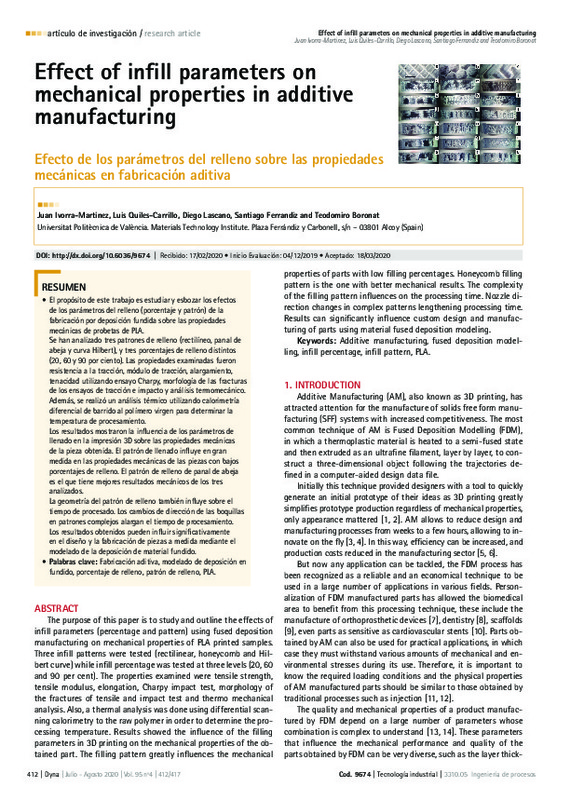|
Resumen:
|
[EN] The purpose of this paper is to study and outline the effects of infill parameters (percentage and pattern) using fused deposition manufacturing on mechanical properties of PLA printed samples.
Three infill patterns ...[+]
[EN] The purpose of this paper is to study and outline the effects of infill parameters (percentage and pattern) using fused deposition manufacturing on mechanical properties of PLA printed samples.
Three infill patterns were tested (rectilinear, honeycomb and Hilbert curve) while infill percentage was tested at three levels (20, 60 and 90 per cent). The properties examined were tensile strength, tensile modulus, elongation, Charpy impact test, morphology of the fractures of tensile and impact test and thermo mechanical analysis. Also, a thermal analysis was done using differential scanning calorimetry to the raw polymer in order to determine the processing temperature.
Results showed the influence of the filling parameters in 3D printing on the mechanical properties of the obtained part. The filling pattern greatly influences the mechanical properties of parts with low filling percentages. Honeycomb filling pattern is the one with better mechanical results.
The complexity of the filling pattern influences on the processing time. Nozzle direction changes in complex patterns lengthen processing time.
Results can significantly influence custom design and manufacturing of parts using material fused deposition modeling.
[-]
[ES] El propósito de este trabajo es estudiar y esbozar los efectos
de los parámetros del relleno (porcentaje y patrón) de la
fabricación por deposición fundida sobre las propiedades
mecánicas de probetas de PLA.
Se ...[+]
[ES] El propósito de este trabajo es estudiar y esbozar los efectos
de los parámetros del relleno (porcentaje y patrón) de la
fabricación por deposición fundida sobre las propiedades
mecánicas de probetas de PLA.
Se han analizado tres patrones de relleno (rectilíneo, panal de
abeja y curva Hilbert), y tres porcentajes de relleno distintos
(20, 60 y 90 por ciento). Las propiedades examinadas fueron
resistencia a la tracción, módulo de tracción, alargamiento,
tenacidad utilizando ensayo Charpy, morfología de las fracturas
de los ensayos de tracción e impacto y análisis termomecánico.
Además, se realizó un análisis térmico utilizando calorimetría
diferencial de barrido al polímero virgen para determinar la
temperatura de procesamiento.
Los resultados mostraron la influencia de los parámetros de
llenado en la impresión 3D sobre las propiedades mecánicas
de la pieza obtenida. El patrón de llenado influye en gran
medida en las propiedades mecánicas de las piezas con bajos
porcentajes de relleno. El patrón de relleno de panal de abeja
es el que tiene mejores resultados mecánicos de los tres
analizados.
La geometría del patrón de relleno también influye sobre el
tiempo de procesado. Los cambios de dirección de las boquillas
en patrones complejos alargan el tiempo de procesamiento.
Los resultados obtenidos pueden influir significativamente
en el diseño y la fabricación de piezas a medida mediante el
modelado de la deposición de material fundido.
[-]
|
|
Agradecimientos:
|
This work was supported by the POLISABIO program grant number (2019-A02).
J. Ivorra-Martinez wants to thank UPV for the grant received through the FPI
program, grant (SP20190011). L. Quiles-Carrillo wants to thank MECD ...[+]
This work was supported by the POLISABIO program grant number (2019-A02).
J. Ivorra-Martinez wants to thank UPV for the grant received through the FPI
program, grant (SP20190011). L. Quiles-Carrillo wants to thank MECD for his
FPU grant (FPU15/03812). D. Lascano wants to thank UPV for the grant received
through the PAID-01-18 program.
[-]
|









